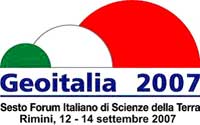Il Poster del Progetto sarà presentato al Palacongressi della Riviera di Rimini in occasione della manifestazione ExpoGeoitalia il 14 settembre 2007 dalle ore 9.00 nell’aula 10 all’interno della sessione dedicata alla ” Biogeochimica e inquinamento delle aree costiere”
Si svolgerà in parallelo con il Sesto Forum Italiano di Scienze della Terra GEOITALIA 2007 (12-14 Settembre) al Palacongressi della Riviera di Rimini in un’ampia area espositiva adiacente la sala plenaria allestita insieme alle aree poster e di ristorazione.
All’interno della sessione 60 – T01 – Biogeochimica e inquinamento delle aree costiere (Convener e Chairperson: Frignani Mauro, Ravaioli Mariangela) sarà esposto al Pannello 116 il POSTER dal titolo: “Hypoxia and Anoxia in the Northern Adriatic Sea within ANOCSIA(MUR-FIRB) and EMMA (UE-LIFE) projects: planning and some (first) results.
Tale occasione rappresenterà l’evento finale per il progetto EMMA e l’opportunità unica di diffusione dei risultati progettuali.
Tutti i partner di EMMA sono caldamente invitati a partecipare a tale giornata. Durante la giornata di venerdì 14 sarà organizzato un Coffee Break.

CNR – Istituto di Scienze Marine – Sede di Bologna, Bologna, ItaliaCatalano G., Luchetta A., Cantoni C., Cozzi S
CNR – Istituto di Scienze Marine – Sede di Trieste, Trieste, ItaliaArneri E., Morello E.,
CNR – Isituto di Scienze Marine – Sede di Ancona, Ancona, Italia
Russo A., Coluccelli A., Iermano A., Negri A., Morigi C., Falco P.,
Dipartimento di Scienze del Mare, Università Politecnica delle Marche, Ancona, Italia
Serratore P., Trentini M.,
Dipartimento di Sanità Pubblica Veterinaria e Patologia Animale, Università degli Studi di Bologna, Centro Ricerche Marine, Cesenatico, Italia
Ferrari C.R., Tarlazzi S.,
Struttura Oceanografica Daphne, ARPA Emilia Romagna, Cesenatico, Italia
Prevedelli D., Simonini R.,
Dipartimento di Biologia Animale, Università degli Studi di Modena e Reggio Emilia, Modena, Italia
Matteucci G.
Gruppo CSA SpA – Rimini, Italia
Bajt. O.,
National Institute of Biology, Marine Biology Station, Piran , Slovenia
Favi E., Stanley C.
Comune di Rimini, Assessorato alle Politiche Ambientali, Settore Ambiente e Sicurezza, Rimini, Italia
Valentini S., Sani D.
ASTER S.cons.P.A., Bologna, Italia
Abstract
The morphologic, oceanographic and climatic characteristics together with the anthropic forcings make the north Adriatic basin an environment particularly suitable to the grow of ipo-anoxic phenomena of its water. During the last decade the increasing frequency of these episodes has caused a relevant economic damage to the North Adriatic coastal regions, particularly to the Emilia Romagna region which is mainly affected for the environmental quality of the coast, for the quality and quantity of the fishery and mariculture products, and for the health defence in bathing zones.
For this reason the ANOCSIA Project (2004-2007) financed by MIUR-FIRB focused on the study of these phenomena in order to identify the natural and anthropical set off processes. Also thanks to the knowledge gained with this project it was at the same time possible to set the basis for a new innovative research project called EMMA. Approved within the LIFE-Environment sector of the E.U. the project has an application-managing value directed to the improvement of the awareness of the necessity to use integrated observational-modellistic-predicting systems for the management of the environment by the authorities who have to administrate the territory, to transfer the scientific-technologic knowledges, by the public administration and by the socio-economic subjects in order to start concerted steps and interventions able to counteract the causes of the marine ecosystem deterioration and to mitigate its impact.
Therefore EMMA aims to create: i) an experimental site for the study anoxic events as integration of the pre-existent monitoring network of the North Adriatic; ii) a space-temporal predicting model (72 h) of O2 concentration iii) short term intervention strategies consisting in temporary rules to manage anoxic events in progress; iv) long term intervention strategies which integrate the present day public instruments of territorial pianification and management through concrete measures for the prevention and reduction of the harmful effects of the anoxic events in the study area; v) identification of possible indicators of anoxic conditions through the study of the behaviour of some ichthyic and mariculture species.
The actions so far realized have been: i) planning and realization of multidisciplinary databases and informatization of the historical maps of the ipo-anoxic events; ii) historical reconstruction of the ipo-anoxic episodes occurred in the North Adriatic.
a) 3 oceanographic cruises for the acquisition of sediment and water column data useful to the characterization of the area under survey also thanks to the integration with the allowable historical data;
b) real time monitoring through the two multiparametric sites E1 and S1 for the acquisition of meteo-oceanographic data useful to implement the 3D predicting model;
c) implementation of a 3-dimensional model for the space-temporal prediction of the O2 concentration in the water;
d) setup of a LIC (Local Information Center), a network for collecting and exchanging data and results of the predicting model;
We will present and discuss here some of the most representative results obtained during the oceanographic campaigns and thanks to the continuous monitoring of the oceanographic buoy and the connections with the predicting models and the managing applications.
- Presentazione del Progetto Emma (32kb – PDF)
- Brochure Progetto Emma (4777kb – PDF)
Collegamenti esterni

